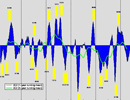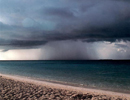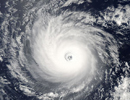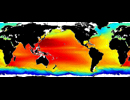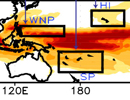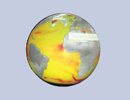Ocean Mixed Layer Depth Climatology
Ocean Mixed Layer Depth (MLD) and Barrier Layer Thickness (BLT) Climatology by Clément de Boyer Montégut, Gurvan Madec, Albert Fischer, Alban Lazar, and Daniele Iudicone
MLD:
The global Mixed Layer Depth (MLD) Climatologies available here are computed from 4,490,571 individual profiles obtained from the National Oceanographic Data Center (NODC) and from the World Ocean Circulation Experiment (WOCE) database. Those are all the high vertical resolution data available since 1941 until 2002, including mechanical bathythermograph (MBT), expendable bathythermograph (XBT), conductivity-temperature-depth probes (CTD), and profiling floats (PFL).
The MLDs are estimated directly on individual profiles with data at observed levels. The MLD is defined through the thresold method with a finite difference criterion from a near-surface reference value. A linear interpolation between levels is then used to estimate the exact depth at wich the difference criterion is reached. The reference depth is set at 10 m to avoid a large part of the strong diurnal cycle in the top few meters of the ocean. The optimal temperature criterion is found to be 0.2 °C absolute difference from surface. The optimal one in density is 0.03 kg/m3 difference from surface.
Reduction of the data is done on a regular 2° by 2° grid for every month, by taking the median of all MLDs in each grid mesh. A slight smoothing is then applied to take account of the noisy nature of ship observations. The last step consisted into an optimal prediction of the missing data using ordinary kriging method. This interpolation was limited to a 1000 km radius disk containing at least 5 grid point values, leaving regions without values instead of filled by a doubtful interpolation. The advantage of kriging is that it is an exact interpolator, and an estimation error in the form of the kriging standard deviation, an analogy to the statistical standard deviation, is also provided.
BLT:
The global Barrier Layer Thickness (BLT) monthly climatology available here is computed from more than 500,000 instantaneous temperature and salinity profiles collected between 1967 and 2002 and obtained from the National Oceanographic Data Center (NODC) and from the World Ocean Circulation Experiment (WOCE) database, complemented by those available between 1996 and 2006 from the ARGO global data centers (e.g., ftp site from Coriolis). Those are all the high vertical resolution data available with both temperature and salinity (conductivity-temperature-depth -CTD- probes, and profiling floats -PFL-).
The BLTs are estimated directly on instantaneous profiles with data at observed levels (see also de Boyer Montégut et al., 2004 for further details). Following most previous authors who studied the Barrier Layer (e.g., Lukas and Lindstrom, 1991; Sprintall and Tomczak, 1992; Vialard and Delecluse, 1998), we define BLT on a profile through the difference between two depths: DT-02 - Dsigma (see Figure on the right). DT-02 is the depth where temperature has decreased by 0.2°C as compared to the temperature at the reference depth of 10 m. Dsigma is the depth where potential density (sigmatheta) has decreased from the reference depth by a threshold equivalent to the density difference for the same temperature change of -0.2°C at constant sea surface salinity.
Reduction of the data is done on a regular 2° by 2° grid for every month, by taking the median of all BLTs in each grid mesh box. Same methodology as for the mixed layer depth climatology (see here for details) is then applied, including a slight smoothing to account for the noisy nature of ship observations, and an optimal prediction of the missing data using ordinary kriging method.
References:
de Boyer Montégut, C., J. Mignot, A. Lazar, and S. Cravatte, Control of salinity on the mixed layer depth in the world ocean. Part I: General description, submitted to J. Geophys. Res., 2006.
Mignot, J., C. de Boyer Montégut, A. Lazar, and S. Cravatte, Control of salinity on the mixed layer depth in the world ocean. Part II: Tropical areas, submitted to J. Geophys. Res., 2006.
d'Ortenzio, F., D. Iudicone, C. de Boyer Montégut, P. Testor, D. Antoine, S. Marullo, R. Santoleri, and G. Madec (2005) Seasonal variability of the mixed layer depth in the Mediterranean sea as derived from in situ profiles, Geophys. Res. Lett., 32, L12605, doi:10.1029/2005GL022463
| Variables | mixed layer depth (m), barrier layer thickness (m) and associated statistics |
| Zonal | Global by 2 deg |
| Meridional | Global by 2 deg |
| Vertical | |
| Temporal | Jan Climatology to Dec Climatology by 1 month(s) |
| Static? | yes |
| Volume | |
| Server | public:      |
| Source | http://www.lodyc.jussieu.fr/~cdblod/mld.html |
| Acquired | Feb 5, 2007 |
| APDRC contact | |
| Supplements |



